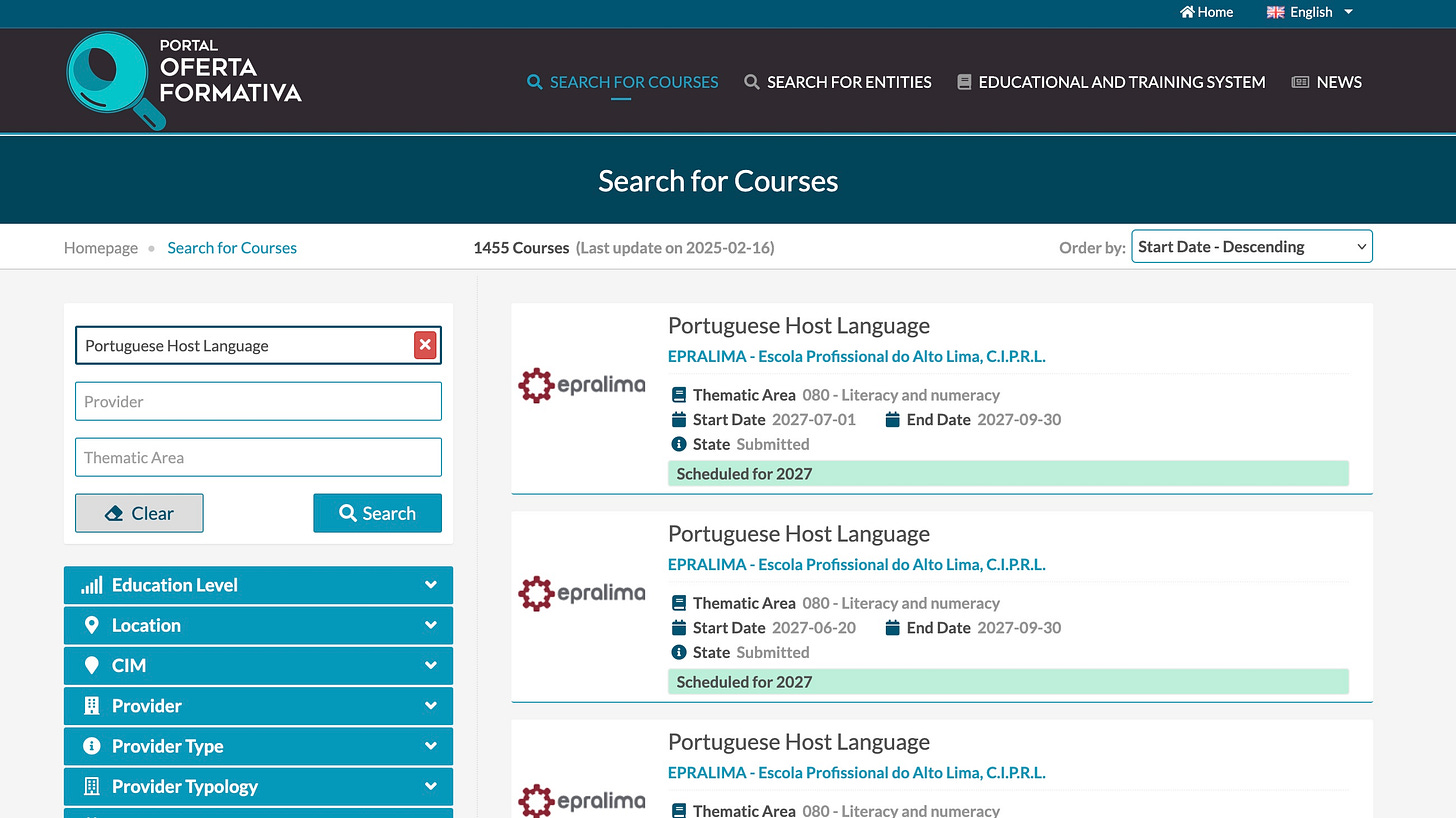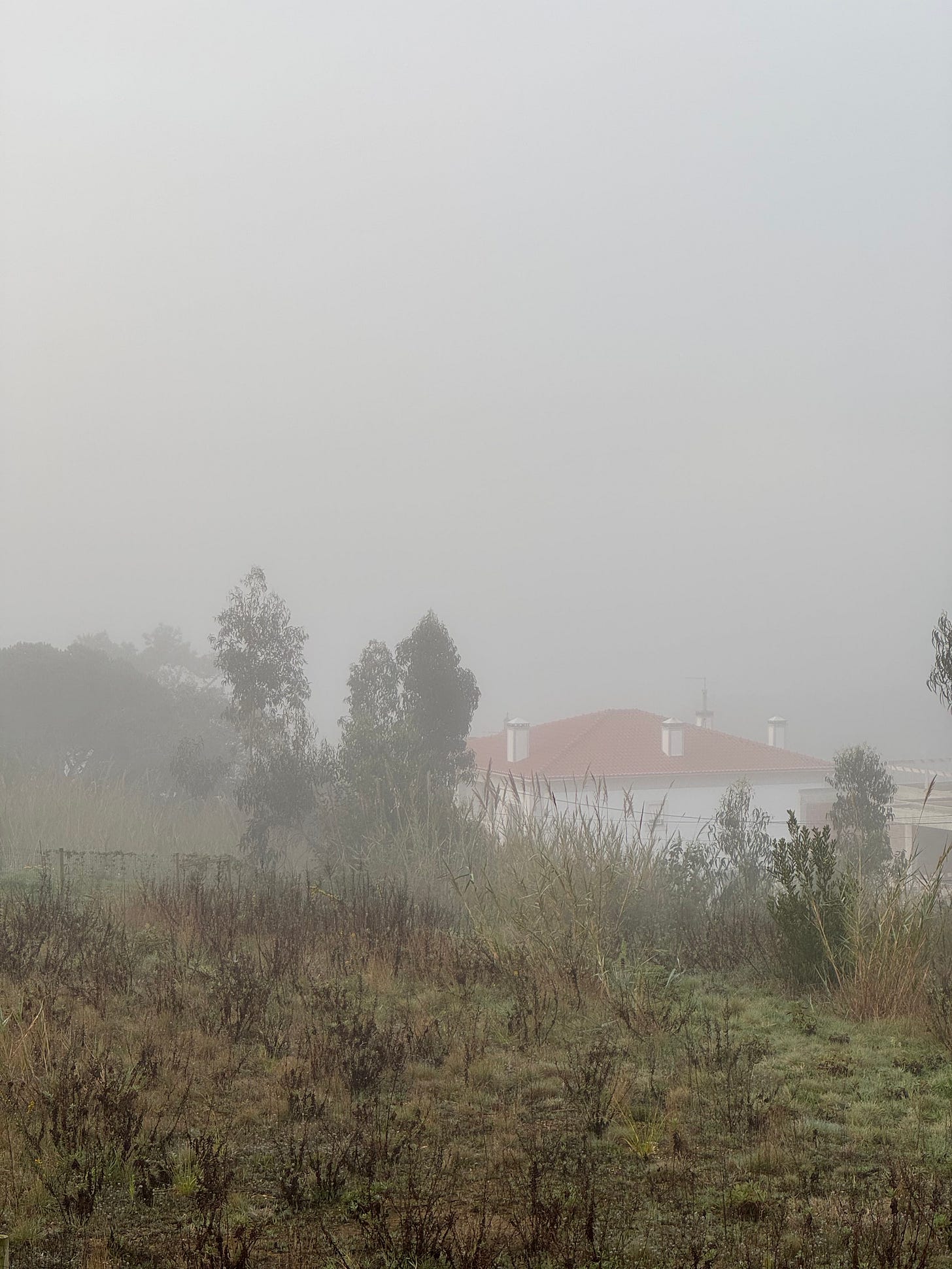Register for the Portuguese (PLA) A1/A2 language class
Use the A2 Certificate for Permanent Residency or Citizenship Application
Many immigrants in Portugal are working to learn the Portuguese language. I would love to be able to speak Portuguese well and chat with my neighbors easily. I want to read the works of Portuguese poets and feel confident when I want, or need, to express my thoughts.
There are plenty of ways to learn a language. Some possibilities include online classes; language apps; in-person group classes; and individual classes. This year, I am taking an A1/A2 in-person class in a nearby town.
What is an A1/A2 Portuguese language class?
Many Americans may not be familiar with the Common European Framework of Reference for Languages (CEFR). This framework is used for several purposes, including to learn, teach or assess a person’s proficiency with a particular language. According to the CEFR, an individal or “basic user” of a language who has an A1/A2 level language proficiency should have the following abilities:
”A1 - Can understand and use familiar everyday expressions and very basic phrases aimed at the satisfaction of needs of a concrete type. Can introduce him/herself and others and can ask and answer questions about personal details such as where he/she lives, people he/she knows and things he/she has. Can interact in a simple way provided the other person talks slowly and clearly and is prepared to help.”
“A2 - Can understand sentences and frequently used expressions related to areas of most immediate relevance (e.g. very basic personal and family information, shopping, local geography, employment). Can communicate in simple and routine tasks requiring a simple and direct exchange of information on familiar and routine matters. Can describe in simple terms aspects of his/her background, immediate environment and matters in areas of immediate need.”
At the successful completion of the A1/A2 Portuguese course, students will receive an A1/A2 certificate. Demonstrating an A2 level of proficiency is required for a permanent residency or citizenship application in Portugal. The A1/A2 certificate fulfills the proficiency requirement.
Alternatively, one could demonstrate proficiency with the Portuguese language by taking the CIPLE exam, which is offered both inside Portugal in several locations and outside Portugal in a variety of countries. If one wants or needs to demonstrate lanugage proficiency before moving to Portugal, taking the CIPLE exam is the best option. However, if one already lives in Portugal, taking a government-sponsored A1/A2 Portuguese language class, sometimes referred to as a PLA class, is an option also. Today’s newsletter is focused on how to find and register for the A1/A2 PLA course and obtain the A1/A2 certificate.
How to Find an A1/A2 Course Nearby
In order to find a list of A1/A2 courses that are close to one’s city or village, go to the Portal da Oferta Formativa. In the top right hand corner, where it says “Português,” cick the drop down arrow and select “English.”
Next, towards the top left-hand side of the site in the text box that states: “Course Title,” enter “Portuguese Host Language.” Alternatively, scroll down the menu on the left-hand side to Study Cycle and then select “Portuguese Host Language.”
Next, under “Location,” on the menu on the left-hand side, select the applicable geographic area. Scroll up and select “Search.”
To further narrow the geographic range for the search, click the drop-down arrow by “CIM” on the left-hand menu and choose one of the options. Then, scroll up and click “Search” again. See the current options for A1/A2 classes in the area.
To find a class that is offered during the day, look at the menu on the left side of the site again and select the drop-down for “Course Timetable.” The options listed are: daytime, nocturnal or mixed. Many of the courses offered are during the nighttime or are a mixture of day and nighttime sessions. The nighttime classes can run quite late in some locations. If there’s not a daytime class offered, try widening the geographic range for classes to find the nearest daytime class.
Verify Class Details
At this point, one should see a manageable list of possible classes. To verify the class level, A1/A2 or B1/B2, click the rectangular listing for a particular class Under course typology, towards the top right-hand corner, one should see either A1+A2 or B1+B2.
Register for a Class
After following the process above, one should see contact details for the organization offering the class: phone number, website; and address. Check the organization’s website for an email address.
When I registered for the PLA class, I used Deepl to translate my English language email to Portuguese. I included both the English version and the Portuguese translation in my email to the entities offering PLA classes in my area. Perhaps consider stopping by in person, if that is a possibility. By email, phone or in-person request information for how to register for the PLA A1/A2 class.
Preference is often given to individuals who live or work in the designated geographic area. The school or other entity will likely provide a registration form in a PDF format or a link to a Google registration form.
Classes are typically limited to 15 -20 students. It’s a good idea to register early in the spring to take a fall class. One may want to apply to take the class in more than one location. In the spring of 2024, I submitted paperwork for four options in the nearest town and then I was offered a spot in May 2024 from one of the entities to which I applied. By June 2024, the September 2024 was full.
Is a Temporary Residence Card Necessary to Register for a PLA Class?
No. When I initially contacted AIMA in the winter of 2024 for information about A1/A2 courses, I was told: “you have a wide sphere of options to be admitted. You can present a residence permit or visa (short term for seasonal work […] or residence). Or a proof of initiation of regularization procedure or a Social Security Number (NISS).” At the time I applied to take the A1/A2 class, I had been approved for my D7 visa, but did not yet have my temporary residence permit.
Is There a Cost for the Course?
In Portugal, the PLA courses are offered through Qualifica centers, Instituto do Emprego e Formação Profissional (IEFP) training centers. and public schools, The courses offered in the IEFP training centers are free. Courses offered through the public schools are free as well, unless the school is also a Qualifca center. Qualifica centers are allowed to charge for the courses. These charges are typically minimal and based on my queries of students who have taken the courses in a variety of towns range from 7 euros to about 22 euros. A student will need to pay for the books the instructor chooses for the course also. This cost may be around 35 euros for new books.
When Will I Learn the Actual Days of the Week and Time of the Day When the Course is Offered?
The school notified me on a Friday that our class would begin the following week. Only at this point were we told the days of the week and the time of each day for our class. Fortunately, I was able to be flexible. I was also thankful to have been accepted into a daytime class.
The Actual Class from September through May
Our class takes place two days a week for 3 hours each of those days. Attending this class and doing the work required is a significant time commitment. In total, the class requires 150 hours of classroom time. We had our A1 exam in January. Our A2 exam will occur in either May or June.
Will I Be Able to Speak Portuguese After I Complete This Course?
I dunno. A student who completes this course will learn about Portuguese grammar and will increase their vocabulary. Based on my experience and my conversations with several other PLA students across the country, most of the class time is typically spent on completing short written exercises and listening to recorded audio files. Students spend very little time practicing pronunciation of Portuguese words or speaking Portuguese. Additionally, not much time is spent on writing sentences or short paragraphs.
A student can supplement what they learn in the PLA class with other ways of learning including language apps, language cafes, or trying one of the many apps designed to connect native speakers with those wanting to learn the language.
Resources
Portal da Oferta Formativa - Provides information on A1/A2 Portuguese (PLA) language classes. See instructions above for how to find classes nearby.
CIPLE - Provides information about what the CIPLE exam is and how it is structured. Includes links to register for the A1/A2 Portuguese language exam and the B1/B2 Portuguese language exam both inside Portugal and in other countries. There are not many spots available for taking the exam and the places that open tend to be filled quickly.
Common European Framework of Reference for Languages (CEFR) - Describes the framework used for learning, teaching and assessing language proficiency.
Instituto do Emprego e Formação Profissional (IEFP) - This link provides a list of towns where the IEFP provides a government-sponsored Portuguese language (PLA) class.
Deepl - Deepl is a useful tool for translating European Portuguese into English and English into Portuguese.
Vegetarian Recipe Worth Trying
Spinach, Tofu and Sesame StirFry - (gift link) We’ve had this simple tofu dinner many times and we love it. Feel free to add twice as much spinach as the recipe lists. That’s the only change we usually make.
This is a reader-supported publication. If you found this newsletter helpful, please click on the heart below or subscribe. I hope you will share the newsletter with anyone who has immigrated to Portugal and is trying to learn the language.








Julie, obrigada por esta informação. We are currently enrolled in a private language school here in Alcobaça but will want to get our A1/A2 as a step towards permanent residency.